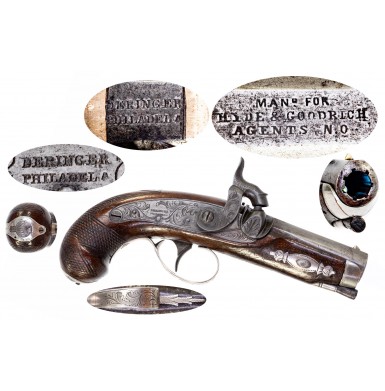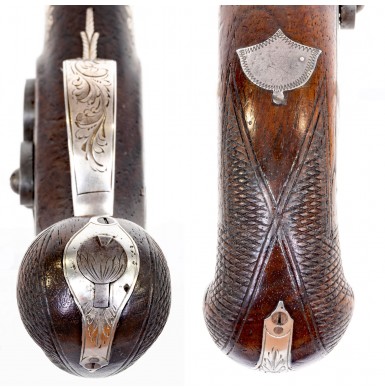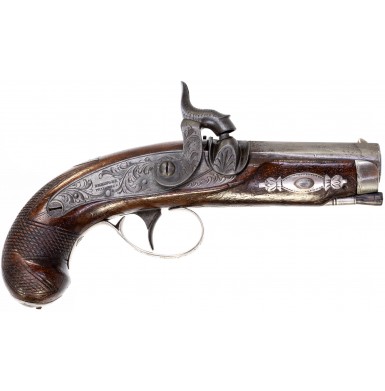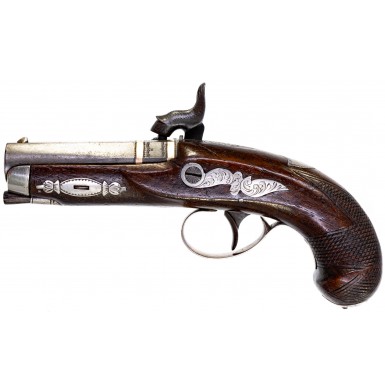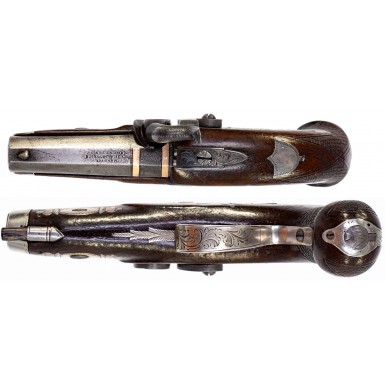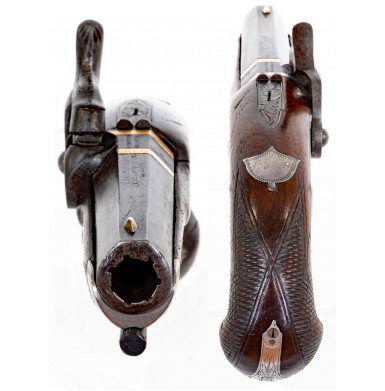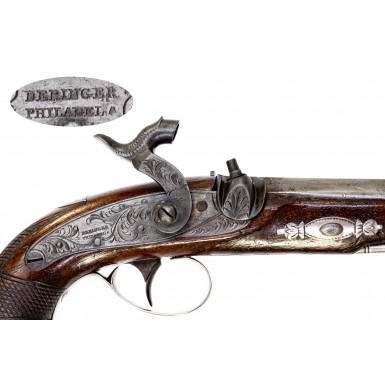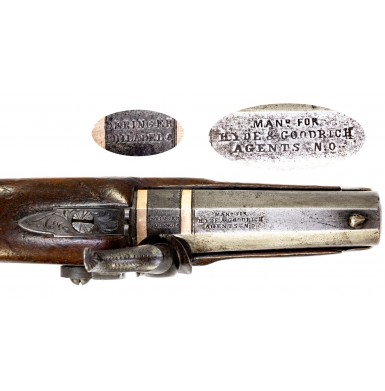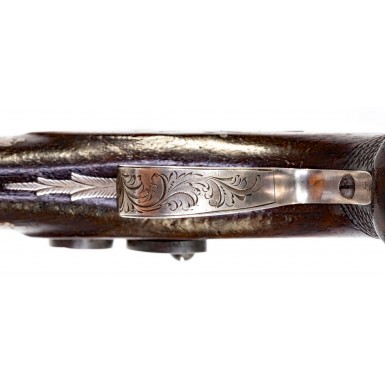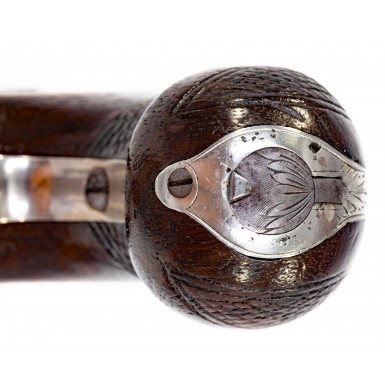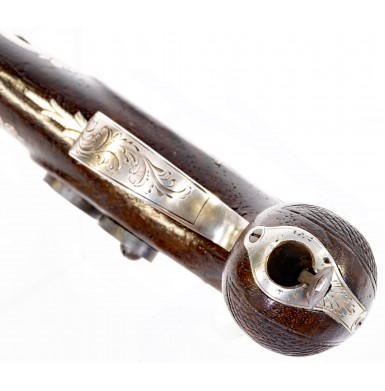Hyde & Goodrich New Orleans Agent Marked Henry Deringer Pocket Pistol
- Product Code: FHG-C105
- Availability: In Stock
-
$5,500.00
In 1816 James N. Hyde established a jewelry company in the growing city of New Orleans, LA. Hyde had been born in Norwich, CT in 1787 (or 1788 – sources vary) and was a partner in the jewelry company Hyde & Nevins in New York City from 1812-1818. Hyde was clearly a canny entrepreneur who saw the expanding markets of United State of America evolving west of the Mississippi river and so he chose New Orleans to establish his new venture. New Orleans was probably the most international city in the United States at the time and had one of the largest ports, handling cargo from around the world as well. European and English imports entered the city on a regular basis, while American exports, primarily raw materials such as cotton, were exported to feed the growing industrial machines of Great Britain and Europe. New Orleans was also a central location for the provisioning of those Americans who had headed west to establish new farms and homesteads and was the nearest major port to allow the export of the items raised and cultivated in the newly settled areas like Texas, which was then still part of Mexico. New Orleans commission merchants provided the capital for western ranchers and cotton growers to start their herds and plants their seeds, with the goods created by the hard-working settlers promised to the merchants against these debts. As a result, New Orleans became the economic center of a newly developing western expansion into territory that would one day become part of the United States.
Hyde’s company was listed in the New Orleans directory of 1822 as a “Jewelry, Military & Fancy Hardware Store”located at 58 Chartres Street, and the following years simply as a “Jewelry Store” at 132 Chartres St. By 1827 the listing read “Military, Jewelry & Fancy Store” and was located at 127 Chartres Street, corner of St. Louis. This general description of the store dealing in military items, which of course included firearms, jewelry and various luxury items would typify Hyde’s company until his death, as well as its successors, into the post-Civil War era. Hyde employed his brother-in-law Charles W. Goodrich, who was another Connecticut transplant, in his business as the primary manager, and sometime around 1830 Goodrich appears to have started working on his own in the same field, but at the same address. This “friendly rivalry” may have been Goodrich’s way to force the issue of becoming a partner with Hyde, and by 1832 the firm was officially known as Hyde & Goodrich. In 1838 James N. Hyde died, but the firm remained in business under Goodrich’s leadership. The firm would descend through the families of the founders with William B. Goodrich and A.L. Hyde taking the reins from their fathers and adding the additional partners of Henry Thomas Jr. and Arthur Breese Griswold. In 1861 as the American Civil War erupted A.L. Hyde withdrew from the business, and the remaining partners reorganized it as Thomas, Griswold & Company. In 1864, with the death of Henry Thomas Jr. the firm was again reorganized, and in 1865 became A.B. Griswold and Company, remaining in business under that name in New Orleans through 1924.
Although the firm of Hyde & Goodrich is heralded as one of the premier silversmiths and retailers in America during the 19th century, much of their bread-and-butter business was certainly along the lines of “military good” and firearms. As early as 1818 advertisements in both the New Orleans Commercial Press and the New Orleans Daily Advertiser noted such items for sale as “elegant swords, pistols, plumes &c…5 cases fowling pieces suitable, for Indian trade…” and the following year an ad noted “12 cases guns, calculated for the Indian trade”. Although the firm no doubt continued to stock arms for the fur traders, trappers, and river men of the region to trade to sell to the Indians, within a couple of years the growth and prosperity of New Orleans is noted in the change of the tenor of their firearms advertising, with the Thursday January 11, 1821, issue of the Louisiana Gazette carrying the following notice:
“Fine Guns! The subscriber has received, per CRISIS, a case of extra fine fowling guns, made by Mortimer.”
This advertisement not only indicates that high grade sporting arms were now part of the Hyde & Goodrich inventory, but that the guns were being imported from Great Britain as well. A July 22, 1822, notice in the same paper lists a plethora of newly arrived arms and military items, but most especially notes “Also a few English duck guns.” and in November of the same year another notice in that paper advertises: “Fine guns. Two cases of double and single barreled guns.” Within a few years their advertisements went well beyond the listing of swords and shotguns, but also included the names of the most prominent of the American arms makers of the time as well, with one listing noting: “Rifles, Mississippi, Kentucky, Cot’s Pistols, Whitney’s, Wesson’s, Allen’s and Sharps. Sold agents for the latter in New Orleans”. The firm continued to import firearms from England as well, and by the late 1850s appeared to have developed an exclusive distributorship for Tranter’s patent revolvers within the region, as examples are known marked:
W. TRANTER’S Patent HYDE AND GOODRICH
AGENTS FOR THE UNITED STATES SOUTH.
As the American Civil War erupted, the firm turned their attention to providing more military goods and arms of a military nature, instead of fine English sporting guns. In July of 1861, with the change of name and the departure of A.L. Hyde, the firm sought to provide a variety of arms to the Confederacy including swords, but the effort was short lived as the Federal capture of New Orleans in the spring of 1862 put an end the company’s foray into the field of selling military arms. These days the guns that are retail marked by Hyde & Goodrich are exceedingly rare and very desirable items for collectors of antebellum southern arms and secondary Confederate weapons. Many of the guns retailed by Hyde & Goodrich in the decades preceding the war were pressed into service with Louisiana volunteers in 1861. In fact, the large majority of the arms carried by the poorly equipped New Orleans home guard that attempted to protect the city from Federal invasion in 1862 were double-barreled shotguns, no doubt procured locally from retailer just like Hyde & Goodrich.
One of the well-known American firearms makers that Hyde & Goodrich offered for sale were the pistols of Henry Deringer, a design that was so influential that Deringer’s name would become synonymous with easily concealable pocket pistols and would even become a generic term for the guns he was famous for producing in the form “derringer” with two “r’s” and a lower case “d”. Like many of Deringer’s pistols sold by larger retailers, the guns were often marked that they were made for Hyde & Goodrich who were Deringer’s “agents”. Deringer had entered the arms business as gun maker in Philadelphia circa 1809 and was receiving US military contracts for rifles as early as 1814. In addition to producing military contract arms, he produced guns for the Indian Trade and for general sale to the civilian population. While much of his first decade or two of arms production seems to have been centered on making rifles and trade guns, he did produce some pistols as well. However, the guns that would make Deringer a household name did not appear on the scene until sometime in the 1820s.
Deringer’s iconic pistols were single shot percussion ignition guns that were produced in a number of calibers and barrel lengths but were typically around .41 to .45 caliber and invariably had rifled bores. The earliest guns used conventional forward action locks but by the late 1830s or so the signature back action percussion lock was being used on most of his pistols. The shape of the barrels and butts evolved as well during the period from their earliest introduction until their pinnacle of popularity from roughly 1852 to the late 1860s. By the late 1840s or the beginning of the 1850s the classic Deringer Bird’s Head grip profile had come into use and this profile would dominate his pocket pistol production until the guns were obsolete. The popularity of Deringer’s design is underscored by his own statement in 1866 that between 1856 and 1866 he produced 5,280 pairs of the pistols, or a total of 10,560 of the pocket-sized guns. This production figure for the most successful period of his handgun making suggest that he probably produced at least 15,000 pocket pistols, if not more, when the roughly two decades of manufacturing prior to 1856 are included as well. The guns were usually mounted with German silver furniture, although higher grade guns could include silver mountings. Some guns were also enhanced with German silver, silver or even gold bands at the breech. Some pistols included a cap box in the butt in the English style. The guns were typically finished with browned barrels with copper streaking to simulate a Damascus steel pattern, and color casehardened locks and hammers. All by the smallest of the guns usually included a ramrod as well. Rudimentary sights were often included on the mid-sized and larger pistols while the smallest guns often only included a front sight blade with the rear sight omitted.
Offered here is a rare and desirable Hyde & Goodrich Agent Marked Henry Deringer Pocket Pistol. The gun is on the larger end of the “small pocket pistol” range or the smaller end of the “medium pocket pistol” size range with a 3” wedge retained flat-topped round barrel and an overall length of about 7”. The pistol is nominally .42 caliber, measured land to land and about .44 caliber measured groove to groove, with the typical Deringer seven groove rifling. The pistol is a higher-grade gun, with engraved mountings apparently of silver rather than German silver and with a pair of gold bands at the breech. The styling of the pistol is typical of the guns that Deringer was producing from the late 1830s to mid-1840s. The triggerguard finial does not include his classic pineapple final motif, a feature that appeared during the latter part of the 1840s. The pistol additionally features a cap box in the butt, a feature that was being eliminated by the late 1840s. The “Bird’s Head” butt profile is also quite rudimentary, being a sort of hybrid of the 1830s to mid-1840s bad shaped grip profile and the later bird’s head profile of the later 1840s through the end of production. The grip shape is much less defined than it would become over the next decade. The color casehardened back action lock is engraved with flowing Arabesque foliate scrolls and is clearly stamped in two lines:
DERINGER
PHILADELA
The breech is stamped in the same fashion with the same marking, flanked by a pair of 1/8” wide gold bands at the breech. Forward of the second gold band the gun is stamped in three lines:
MAND FOR
HYDE & GOODRICH
AGENTS N.O
The left angled flat at the breech has the engraved “sunburst” borderline pattern flanking a weak P proof. The pistol is equipped with a rudimentary fixed sight on the top of the engraved breech plug tang and with a German silver blade front sight near the muzzle. The engraved silver mountings include the nosecap, ramrod ferrule, barrel wedge escutcheons, the rounded triggerguard and finial, the flowing single screw sideplate and the surround of the cap box in the butt. There is also a shield shaped escutcheon in the thumb plate position on the top of the grip with light borderline engraving, but which has not been engraved with a name or initials. The cap box lid is blued steel and engraved ensuite. A simple wood ramrod is in the ramrod channel that fits and looks good but is a more recent replacement and does not appear to be from the period of use.
The pistol remains in about VERY GOOD+ condition and is crisp throughout with clear markings and sharp engraving. The barrel retains none of the browned finish and has a mostly dull pewter gray patina with scattered light surface oxidation, age discoloration and freckles of darker patina. The metal is mostly smooth with some scattered pinpricking and some minor flecks of light surface roughness. The lock has somewhat mottled darker gray patina with some scattered minor surface oxidation. The mottled grays suggest the original case coloring that was on the lock. The action of the pistol remains crisp and fully functional on both the half cock and full cock positions. The cap box lid in the butt also functions as it should. The bore is VERY GOOD as well, with crisp rifling that is characteristically deep. The bore is dark and moderately oxidized with scattered light pitting. The stock of the pistol remains VERY GOOD as well and shows the moderate wear associated with pocket pistols that were carried with some degree of regularity. The wood does not show any indications of having been sanded and still retains relatively crisp checkering at the grip. The stock does show a moderate number of scattered bumps, dings and mars from carry and use, as well as short grain crack that runs from the lock mounting screw into the barrel channel.
Overall, this is a really lovely, high-grade example of a scarce and desirable antebellum Hyde & Goodrich Agent Marked Henry Deringer Pocket Pistol. This gun would have likely been sold in New Orleans in the decade before the Mexican American War and was probably carried as a self-defense pistol by a wealthy merchant or landholder in the region. The gun could well have gone off to the Mexican War in the pocket of an officer or even been in the pocket of an early Civil War southern volunteer from New Orleans. Hyde & Goodrich marked weapons are generally considered secondary Confederate arms, even civilian ones, and are always sought by collectors of Confederate arms as well. Whether you specialize in Deringer pistols, southern agent marked arms or just collect antebellum through Civil War period New Orleans retailed items, this wonderful little pistol will be a fine addition to your collection that I think you will be very happy with.
Tags: Hyde, Goodrich, New, Orleans, Agent, Marked, Henry, Deringer, Pocket, Pistol

